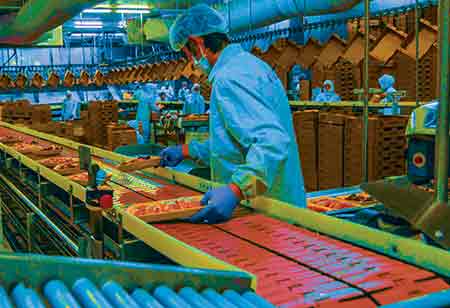Thank you for Subscribing to Food Business Review Weekly Brief
F&B Industry: IIoT turns day-to-day operations into a game-changer
Any object or being can function as a computer, connect to the internet, feel the environment, collect information, and offer perspectives on the fly.

By
Food Business Review | Thursday, February 17, 2022
Stay ahead of the industry with exclusive feature stories on the top companies, expert insights and the latest news delivered straight to your inbox. Subscribe today.

IIoT is evolving workflow approaches succeeded by food and beverage companies to optimize their day-to-day activities with safety, product quality, packaging, and staff.
Any object or being can function as a computer, connect to the internet, feel the environment, collect information, and offer perspectives on the fly. From the time that food grows on the farm to the time it is reflected on the supermarket shelves, every morsel of food can be monitored and traced back to its source with the industrial internet of things (IIoT).
F&B (Food and beverage) is an economically significant and quickly advancing sector driven by expectations of meeting high regulatory, food security, and quality standards. On the other hand, companies are continuously under pressure to innovate and optimize productivity without compromising product quality.
Globally, as food safety regulations become more stringent, producers are forced to believe a few steps forward and create future proof of procedures and manufacturing lines.
IIoT provides highly functional connectivity, information collection skills, and velocity for food and beverage companies. By connecting devices to gather operational information throughout a manufacturing setting, the IIoT can simplify checks on food safety.
IIoT can play a major role in maximizing food safety by tracking distant temperatures and circumstances. Producers can employ this data to automate slow, manual surveillance procedures of distinct cooling units, thereby increasing manufacturing effectiveness by saving time and labor.
IIoT can help producers ensure that their food is free of all risks and faces regulatory difficulties. On the network's margin, automated devices will test samples in-line and give data from chemical and spectroscopic analysis in real-time. Analyzing food manufacturing in real-time can also reduce the response time in possible decontaminating attempts. This dramatically diminishes the expenses associated with quality issues of food and water waste.
The IIoT's capacity to significantly streamline food and beverage manufacturing regulatory processes is another advantage. Manufacturers can gather, evaluate and communicate manufacturing information using IIoT equipment at the bottom of the network.
This real-time information can help manufacturing plants identify the measures to correct food safety and boost their response time. Food and beverage companies can ensure that they prevent regulatory penalties and safeguard their brand from reputational risk by helping to anticipate regulatory non-compliance.
IIoT stays here and enhances the operational efficiencies of companies around the globe. However, to guarantee a better product from the idea and leverage its full company potential, an ideal IIoT application needs to be taken seriously. The execution of IIoT within F&B manufacturing's purview has begun, but there is still a long way to go before it can become omnipresent. The potential is immense, but it takes time for wide acceptance.






